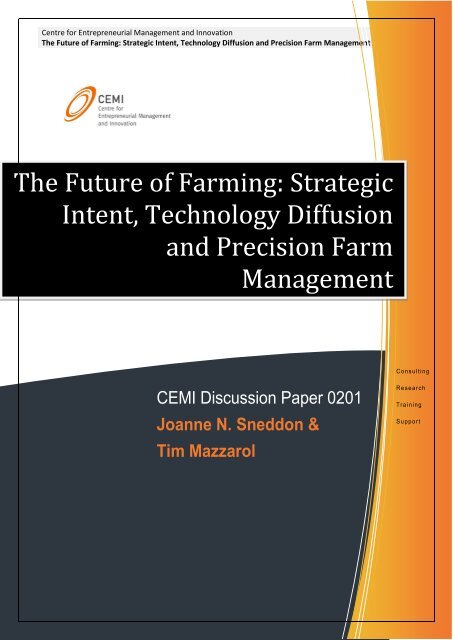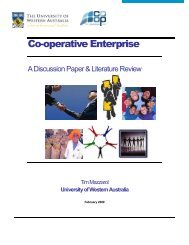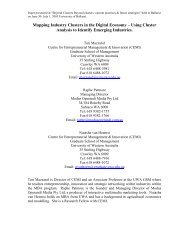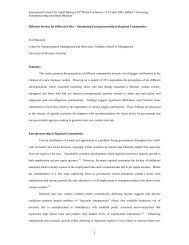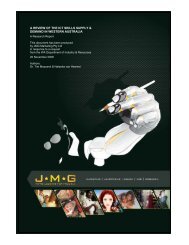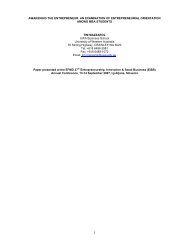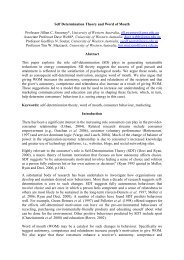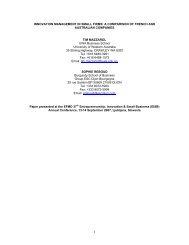The Future of Farming: Strategic Intent, Technology Diffusion ... - CEMI
The Future of Farming: Strategic Intent, Technology Diffusion ... - CEMI
The Future of Farming: Strategic Intent, Technology Diffusion ... - CEMI
You also want an ePaper? Increase the reach of your titles
YUMPU automatically turns print PDFs into web optimized ePapers that Google loves.
Centre for Entrepreneurial Management and Innovation<strong>The</strong> <strong>Future</strong> <strong>of</strong> <strong>Farming</strong>: <strong>Strategic</strong> <strong>Intent</strong>, <strong>Technology</strong> <strong>Diffusion</strong> and Precision Farm Management1<strong>The</strong> <strong>Future</strong> <strong>of</strong> <strong>Farming</strong>: <strong>Strategic</strong><strong>Intent</strong>, <strong>Technology</strong> <strong>Diffusion</strong>and Precision FarmManagementCentre for Entrepreneurial Management and Innovation | www.cemi.com.au
Centre for Entrepreneurial Management and Innovation<strong>The</strong> <strong>Future</strong> <strong>of</strong> <strong>Farming</strong>: <strong>Strategic</strong> <strong>Intent</strong>, <strong>Technology</strong> <strong>Diffusion</strong> and Precision Farm Management2Centre for Entrepreneurial Management and InnovationPhone: +618 6488-3981Fax: +618 6488-1072Email: tim.mazzarol@uwa.edu.auGeneral Inquiries:Email: admin@cemi.com.auWebsite: www.cemi.com.au<strong>CEMI</strong> Discussion Paper SeriesISSN 1448-2541Discussion Paper 0201© Copyright Joanne Sneddon and Tim Mazzarol 2002Discussion Papers should not be reproduced without attribution to the author(s) as the source <strong>of</strong> the material.Attribution for this paper should be:Sneddon, J.N., and Mazzarol, T. (2002) “<strong>The</strong> <strong>Future</strong> <strong>of</strong> <strong>Farming</strong>: <strong>Strategic</strong> <strong>Intent</strong>, <strong>Technology</strong> <strong>Diffusion</strong> andPrecision Farm Management” <strong>CEMI</strong> Discussion Paper Series, DP 0201, Centre for Entrepreneurial Managementand Innovation, www.cemi.com.auNOTE:This paper was originally published by <strong>CEMI</strong> when it was part <strong>of</strong> the Graduate School <strong>of</strong> Management, <strong>The</strong>University <strong>of</strong> Western Australia, 35 Stirling Highway Crawley WA 6009.Centre for Entrepreneurial Management and Innovation | www.cemi.com.au
Centre for Entrepreneurial Management and Innovation<strong>The</strong> <strong>Future</strong> <strong>of</strong> <strong>Farming</strong>: <strong>Strategic</strong> <strong>Intent</strong>, <strong>Technology</strong> <strong>Diffusion</strong> and Precision Farm Management3THE FUTURE OF FARMING: STRATEGIC INTENT,TECHNOLOGY DIFFUSION AND PRECISION FARMMANAGEMENTJoanne N. Sneddon, University <strong>of</strong> Western Australia (joanne.sneddon@uwa.edu.au)Tim Mazzarol, University <strong>of</strong> Western Australia (tim.mazzarol@uwa.edu.au)ABSTRACTThis paper examines the application <strong>of</strong> new technologies to precision agriculture, with specific reference to thewool industry in Australia. It argues that the adoption <strong>of</strong> new innovation is essential to the long-termsustainability <strong>of</strong> the industry, but cautions that the diffusion <strong>of</strong> such technologies is likely to depend on thestrategic intent <strong>of</strong> the wool producers. Multiple case studies are presented to illustrate how the strategicmanagement approaches adopted by wool producers will influence the potential adoption issues facing suchnew technologies. Propositions for the future diffusion <strong>of</strong> new technologies are outlined.Key words: strategic intent, innovation diffusion, farming enterprises.RESPONDING TO THE MARKET WITH INNOVATIONAgainst a backdrop <strong>of</strong> declining terms <strong>of</strong> trade and increasing competition it has become increasinglyimportant for Australian wool producers to adopt innovations that will have a positive impact upon enterpriseproductivity and pr<strong>of</strong>itability (Beare, 1999). Although innovative technologies are available to help woolproducers become more productive and pr<strong>of</strong>itable, change in the wool industry is slow compared with otherbroad acre enterprises (McLachlan, 1999). Wool producers have traditionally relied upon wool prices to liftpr<strong>of</strong>itability, rather than introducing innovations that will help reduce production costs or increase fibrequality (Burbidge 1999).<strong>The</strong> relatively low cost <strong>of</strong> managing pastures is considered to be <strong>of</strong> great international competitive advantageto Australia’s wool industry (Chapman and MacMillan 2000). However, much inefficiency exists within theAustralian grazing system with the average wool producer utilising around 30 per cent <strong>of</strong> green feed,compared with 80 per cent <strong>of</strong> feed utilised in intensive farming operations (Grimm 1998). <strong>The</strong> optimal greenfeed utilisation level for the average wool enterprise is around 60 per cent indicating a great potential forproducers to graze more sheep and grow more wool (Grimm 1998). <strong>The</strong> general under-utilisation <strong>of</strong> pastures isa result <strong>of</strong> producers stocking their wool enterprise to survive the poorest growing season rather than stockingto a rate that maximises the conditions <strong>of</strong> the actual season. This conservative approach to feed utilisation islargely due to the lack <strong>of</strong> reliable and timely pasture management information available to wool producers.In response to the underutilisation <strong>of</strong> green feed among wool producers, CSIRO and WA Department <strong>of</strong>Agriculture (WADA), in conjunction with the Western Australian Department <strong>of</strong> Land Administration (DOLA),formed a research consortium to develop remotely sensed pasture management technologies for woolproducers and other extensive graziers. <strong>The</strong> main objective <strong>of</strong> the consortium was to develop and deliverCentre for Entrepreneurial Management and Innovation | www.cemi.com.au
Centre for Entrepreneurial Management and Innovation<strong>The</strong> <strong>Future</strong> <strong>of</strong> <strong>Farming</strong>: <strong>Strategic</strong> <strong>Intent</strong>, <strong>Technology</strong> <strong>Diffusion</strong> and Precision Farm Management4technologies that quantify green feed available to livestock. This data will enable producers to budget theirfeed during the winter growing season and adjust stocking rates to maximise seasonal conditions. To dateresearch and development has yielded methodologies to derive Pasture Growth Rate (PGR) and Feed-on-<strong>of</strong>fer(FOO) from remotely sensed satellite images and other spatial data at the regional, property and sub-paddocklevel. FOO quantifies the green feed available in kilograms per hectare. PGR estimates net pasture growth at aspecific location in kilograms per hectare per day. Together these data allow producers to accurately budgetgreen feed and manage intake per grazing animal. <strong>The</strong>se technologies may be used to reduce production costsby increasing feed utilisation and stocking rates and to increase the value <strong>of</strong> wool fibre grown by manipulatingfibre design through managing feed intake.Although there is evidence that lower costs <strong>of</strong> production and improved fibre quality are rewarded by themarket it is uncertain whether wool producers will bear the production and market risks associated withadopting such innovations. <strong>The</strong>refore an understanding <strong>of</strong> the factors affecting adoption was required to aidthe development and commercialisation <strong>of</strong> these technologies. <strong>The</strong> issue <strong>of</strong> innovation adoption by farmershas been explored in numerous studies focusing on establishing a relationship between farm and farmerdemographics and their propensity to adopt innovations. However the high level <strong>of</strong> diversity among Australianwool producers and the complex nature <strong>of</strong> the wool enterprise require greater exploration <strong>of</strong> the internal andexternal factors influencing adoption.TECHNOLOGY DIFFUSION AND INNOVATION<strong>The</strong> diffusion <strong>of</strong> innovations has been examined from both an individual and organizational perspective.Rogers (1962; 1983) ‘diffusion <strong>of</strong> innovation theory’ and Davis, Bagozzi and Warshaw (1989) ‘technologyacceptance model’ are examples <strong>of</strong> individual innovation and diffusion models. According to Rogers (1962) thediffusion <strong>of</strong> an innovation is contingent on five perceived attributes: relative advantage, complexity,compatibility, trialability, and observability. <strong>The</strong> adoption <strong>of</strong> any new technology is likely to be influenced bythese five attributes, with end-users accepting or rejecting the innovation in terms <strong>of</strong> how well it satisfiesthese criteria in various combinations. By contrast the technology acceptance model has only two perceivedattributes: usefulness and ease <strong>of</strong> use (Davis, Bagozzi and Warshaw, 1989). Research into organizationaladoption and diffusion <strong>of</strong> innovations has identified a two-stage process involving first a decision by the firm’smanagement to adopt the technology, then the implementation stage in which the end-users are engaged(Zaltman, Duncan and Holbeck, 1973; Leonard Barton and Deschamps, 1988; Lucas, Ginzberg and Schultz,1990).In many cases the failure <strong>of</strong> a new innovation to be adopted is due to an inadequate understanding <strong>of</strong> thedynamics associated with the technological feasibility and the market demand for the technology. Innovationis a multidimensional concept that can involve product or process, technological or administrative, andincremental or radical changes (Cooper, 1998). <strong>The</strong> fact that a new technology is technologically feasible andmay fill a particular need within the market does not mean that it will be readily accepted by the end-user ifthat party is unwilling to adopt it (Price, 1996). Resistance to technology adoption can be attributed to factorsinherent within the organization such as structural or systems issues impeding innovation and change. It canalso be found within the individual and can involve psychological and emotional factors. According to Gallivan(2001) the success a new innovation has in becoming adopted and diffused is likely to be adversely affected incircumstances where: 1) ‘adoption occurs within an organizational setting where users are mandated to usethe innovation’; 2) ‘adoption is subject to heavy coordination requirements or strong interdependencies acrossmultiple adopters’; 3) ‘adoption requires extensive, specialized training to learn the principles underlying theinnovation, in order to overcome knowledge barriers to use; or 4) ‘adoption and use occur within anCentre for Entrepreneurial Management and Innovation | www.cemi.com.au
Centre for Entrepreneurial Management and Innovation<strong>The</strong> <strong>Future</strong> <strong>of</strong> <strong>Farming</strong>: <strong>Strategic</strong> <strong>Intent</strong>, <strong>Technology</strong> <strong>Diffusion</strong> and Precision Farm Management5organizational setting, but only a single respondent is available to vouch for the innovation use <strong>of</strong> many otheremployees in the organization’.Within the wool production enterprise the decision to adopt a new technology such as remotely sensed FOOand PGR data for application in precision farming likely to be taken more at an individual than anorganisational level. However, the farm enterprise is typically comprised <strong>of</strong> a family unit with the economiccontext surrounding the farm household and the level <strong>of</strong> knowledge and understanding possessed by thepotential adopters <strong>of</strong> the technology and its benefits (Neill and Lee, 2001). A comprehensive review <strong>of</strong> farminginnovation adoption carried out by Guerin and Guerin (1994) found that such factors as farmer isolation fromfield days and demonstrations, the absence <strong>of</strong> group leaders, an aversion to technology and limited educationwere all highly likely to serve as barriers to innovation diffusion.THE ROLE OF STRATEGIC INTENT IN INNOVATION ADOPTION<strong>The</strong> concept <strong>of</strong> ‘strategic intent’ has been recognised in the strategic management literature as important inorder to understand the general direction in which a business is headed (Proctor, 1997). Hamel and Prahalad(1989) argue that ‘real’ strategy requires an understanding <strong>of</strong> strategic intent. According to this view strategicintent is a clear expression <strong>of</strong> the general goal or aim <strong>of</strong> the organization that assists in guiding it forward. It iswider and stronger than a vision statement and defines the purpose <strong>of</strong> the organization. It serves to unite orrally all members <strong>of</strong> the organization. For strategic intent to be effective it should be stable over time andfocused on the competition and the market (Przybylowicz and Faulkner, 1993). <strong>Strategic</strong> intent defines theoverall purpose and orientation <strong>of</strong> the organization and can be used to create a common sense <strong>of</strong> urgency toimprove competitiveness and transform behaviour and structure. For strategic intent to be a positive force itshould be focused on competition and how to enhance the overall competitiveness <strong>of</strong> the organization.Marketing theory defines this as adopting a ‘marketing orientation’ in which the organization places its focuson the needs <strong>of</strong> customers and adapts its operations to best respond to these needs. However, this is only part<strong>of</strong> the strategic intent process. Also required is a constant examination <strong>of</strong> what competitors are doing (Hameland Prahalad, 1989). Managers seeking to adopt competitive strategic intent should look for innovations thatenable their organizations to define new rules for doing business and to encourage all employees and otherrelevant stakeholders to accept the challenge posed by this ambition.Within the wool industry, the ability <strong>of</strong> wool production enterprises to align their strategic intent with theadoption <strong>of</strong> technologies and practices can have a critical impact on their ability to achieve sustainablecompetitive advantage. Collier (1985) and Hatfield (2001) identified the development <strong>of</strong> a long-term,technology strategy as a key-influencing factor in the adoption <strong>of</strong> new technologies by organisations. However,the link between strategy and adoption <strong>of</strong> innovations on farms is not considered in the body <strong>of</strong> agriculturalinnovation adoption research. This may be because as Mesiti and Vanclay (1996) point out, the farmingenterprise is considered by many researchers to be a social rather than business system. Farm managementdecisions are not therefore considered to be economically rational but are largely governed by social andcultural constraints. Developers <strong>of</strong> new technologies such as satellite imaging data for measuring pasturegrowth rates must therefore have an in depth understanding <strong>of</strong> the wool producer’s social context, attitudesand strategic management approach.METHODOLOGY<strong>The</strong> methodology for this research involved a multiple case study design comprising four wool producers inWestern Australia. Yin (1994: 13) defines a case study as “an empirical inquiry that investigates acontemporary phenomenon within its real life context; especially when the boundaries between phenomenonCentre for Entrepreneurial Management and Innovation | www.cemi.com.au
Centre for Entrepreneurial Management and Innovation<strong>The</strong> <strong>Future</strong> <strong>of</strong> <strong>Farming</strong>: <strong>Strategic</strong> <strong>Intent</strong>, <strong>Technology</strong> <strong>Diffusion</strong> and Precision Farm Management6and context are not clearly evident.” Its value as a research tool is its ability to measure and record behaviourat close range, thereby enabling the researcher and participants to interpret the reality <strong>of</strong> their experience,and develop a grounded understanding <strong>of</strong> how that behaviour has taken place (Chetty, 1996). Case studymethod is considered a more appropriate strategy where the research is seeking to answer questionsassociated with the ‘how’ and ‘why’ and where control over events is not possible or essential.<strong>The</strong> case study approach was employed in this research study as an appropriate method <strong>of</strong> exploring theinteraction between wool producers and the remotely sensed FOO and PGR technologies during a technologyfield trial in 2001. As case study design employs ‘replication logic’ rather than ‘sampling logic’ each case wasviewed as an independent study with the researcher seeking to identify patterns across the cases to revealnew theory or support existing theory (Yin, 1989). <strong>The</strong> multiple case study approach allowed similarities anddifferences to be examined across four cases, with the primary wool producer selected as the unit <strong>of</strong> analysis.<strong>The</strong>se wool producers were members <strong>of</strong> WADA’s Precision Wool Production project and technology field trialparticipants. <strong>The</strong> case study participants were selected to represent northern, central and southern areas <strong>of</strong>the WA wool-belt. Table 1 outlines the four cases examined in this research study.Semi-structured interviewing techniques were used to collect case study data. <strong>The</strong>se interviews were carriedout with case study participants over a period <strong>of</strong> five months in conjunction with the FOO-PGR field trial.Interviews were conducted with the wool producer, lasting between one and two hours. Question guidelineswere forwarded to producers prior to the interviews to enable them to consider their responses and prepareany supporting evidence required. However question schedules were used only as a guide in that theyprovided a framework for the interview. Documentation relating to the producer’s enterprise type andmanagement techniques was used to triangulate interview responses. This documentation was provided bythe WADA and described the producer’s enterprise type, structure, management and performance over time.Each case was analysed independently and in relation to the other cases, so that key themes could beidentified, and conclusions drawn as to the factors potentially affecting to adoption <strong>of</strong> remotely sensed FOOand PGR technologies.TABLE 1: CASE STUDY PROFILESCase Study One Two Three FourLocation: Jingalup Dandaragan Brookton DandaraganSize <strong>of</strong>1,852 hectare 2,700 hectare 1,270 hectare 2,000 hectareProperty:Land use: Mixed Wool andCropsMixedLivestockMixed Wool andCropsMixed Wool andCropsYin’s (1994) pattern matching approach was used to analyse each case and seek patterns for generalisationacross the cases. <strong>The</strong> findings from each case were reduced to key issues in key categories depending upon thefrequency that they arose in the discussions in order to determine the factors most likely to affect theadoption <strong>of</strong> FOO and PGR technologies.RESULTSENTERPRISE STRUCTUREFour dimensions relating to enterprise structure were found to occur frequently across the case studies. <strong>The</strong>sewere: level <strong>of</strong> sensitivity to external forces, extent <strong>of</strong> enterprise diversification, access to on-farm resourcesand grazing management tactics. Impacts <strong>of</strong> external forces such as commodity price volatility and adverseCentre for Entrepreneurial Management and Innovation | www.cemi.com.au
Centre for Entrepreneurial Management and Innovation<strong>The</strong> <strong>Future</strong> <strong>of</strong> <strong>Farming</strong>: <strong>Strategic</strong> <strong>Intent</strong>, <strong>Technology</strong> <strong>Diffusion</strong> and Precision Farm Management7seasonal conditions are not within the control <strong>of</strong> the wool producer but need to be managed effectively forpr<strong>of</strong>itability and sustainability. Sensitivity to seasonal conditions and commodity prices may provide someclues as to whether producer’s are likely to adopt an innovation as, the more sensitive the enterprise is toexternal forces, the greater the need to adopt innovative practices to overcome production and market risk(Chapman and MacMillan 2000).All cases were sensitive to external conditions but seasonal conditions were most likely to affect case one andcase two because they were farming as close to maximum pasture utilisation as possible within their existingenterprise structure. <strong>The</strong>se enterprises had sought to maximise pasture utilisation by increasing stocking ratesbeyond the district average (case one) or by rotating livestock frequently for maximum grazing coverage (casetwo). <strong>The</strong>refore late season breaks or poor winter rains may leave these farms without access to feed for theirstock.All four cases were affected by the fluctuating price for fine wool but each had adopted a slightly differententerprise structure in response to this situation. Case three had committed to a long-term breeding programaimed at growing finer, higher value wool fibre, making the wool enterprise vulnerable to price fluctuations inthe fine end <strong>of</strong> the wool market. However, this reliance on the price <strong>of</strong> fine wool was balanced by an extensivebroad acre cropping program. Case one had also introduced cropping into their farm system. This approachwas used to reduce market risk in terms <strong>of</strong> shifting reliance away from wool income and also production risk interms <strong>of</strong> providing additional feed for livestock during the summer months. In contrast case two and case fourhad been able to counter volatile market conditions by diversifying into prime lamb and sheep meatproduction and maintaining a medium wool merino flock. <strong>The</strong>re was a greater felt need for remotely sensedpasture management information among case studies with high stocking rates or rotational grazing systemsthan those with fine wool breeding programs and large meat enterprises. This may be because <strong>of</strong> the greaterreliance that these producers have on converting pasture into pr<strong>of</strong>itable wool fibre.All four cases had limited access to farm labour and considered themselves ‘time-poor’. Case two haddeliberately moved towards a less labour intensive operation to reduce labour costs and to free up more <strong>of</strong>the farm family’s time, therefore labour saving technologies were highly valued by this producer. In case three,the producer felt that he was constrained by a lack <strong>of</strong> time to trial new ideas and was concerned about thedifficulties <strong>of</strong> employing good quality labour. <strong>The</strong> lack <strong>of</strong> access to on-farm labour is a problem for many woolproducers and has been attributed to poor pr<strong>of</strong>itability and returns on investment (Beare 1999) and to thegeneral increase in farm size (Craik 2000). Without the being time available to trial and evaluate innovations itis unlikely that the case study producers would be able to adopt new technologies.While cases one, three and four used the Internet to access a range <strong>of</strong> information including weather andmarket data and for email communication; case two struggled to access information via the Internet due to alack <strong>of</strong> knowledge. Although this producer had access to both a computer and the Internet on the farm lack <strong>of</strong>computer skills and confidence with these technologies acted as a major barrier to use. Although three out <strong>of</strong>four <strong>of</strong> the case study producers were comfortable accessing data via the Internet, without adequate trainingit is unlikely that producers like case four would be able to use technologies such as FOO and PGR delivered viathe Internet.THE INFLUENCE OF TASK NETWORKSTask networks are made up <strong>of</strong> customers, suppliers, colleagues and employees (Gibb 1996). <strong>The</strong> attitude <strong>of</strong>producers towards innovations can act as a major constraint in the adoption <strong>of</strong> innovations (Guerin and Guerin1994); producers tend to work closely together in producer groups and are likely to be influenced by theattitudes <strong>of</strong> their peers. <strong>The</strong> level <strong>of</strong> influence that task networks have over producers depends upon theCentre for Entrepreneurial Management and Innovation | www.cemi.com.au
Centre for Entrepreneurial Management and Innovation<strong>The</strong> <strong>Future</strong> <strong>of</strong> <strong>Farming</strong>: <strong>Strategic</strong> <strong>Intent</strong>, <strong>Technology</strong> <strong>Diffusion</strong> and Precision Farm Management8nature <strong>of</strong> the network relationship (Lowenberg-DeBoer and Swinton 1995) and the value <strong>of</strong> those relationshipsas perceived by the producer. <strong>The</strong> case studies demonstrated the strong influence <strong>of</strong> producer groups in theacceptance <strong>of</strong> innovations. A recurring theme in network relationships was the importance <strong>of</strong> meeting withother like-minded producers with whom information and experiences could be shared. For example, case onefelt that learning independently <strong>of</strong> others was ‘worth only half its cost’. <strong>The</strong> high value that this producerplaced on interaction with his peers was evident through his participation in a number <strong>of</strong> different producergroups, including WADA’s Precision Wool Production and the local Holistic Management group. <strong>The</strong> otherthree cases also described interaction with like-minded producers through groups, such as the WADA’sPrecision Wool Production, as valuable.Although these case studies highlighted the high value placed on peer relationships, they did not provideevidence <strong>of</strong> valued relationships with suppliers and buyers. Case one and four felt that the wool supply-chainwas not sophisticated enough to support the adoption <strong>of</strong> innovations that would improve the design <strong>of</strong> theirfibre. <strong>The</strong>se producers described transaction based relationships with brokers who are responsible for‘marketing’ their wool. Although case four had encouraged her clients to establish direct relationships withwool buyers, there was no evidence <strong>of</strong> such relationships among the case study producers. Without clearmarket demand for ‘designed’ fibre, producers such as those represented by the case studies are more likelyto focus upon reducing costs <strong>of</strong> production than increasing wool value through technologies such as remotelysensed FOO and PGR.STRATEGIC INTENTAs noted earlier, the ability <strong>of</strong> firms to align their strategic intent with the adoption <strong>of</strong> technologies is likely toimpact upon their ability to achieve sustainable competitive advantage (Collier 1985; Hatfield 2001). Given thelong-term nature <strong>of</strong> breeding programs and grazing system establishment, producers need to be able to planstrategically for their enterprise. All four case study producers carried out some form <strong>of</strong> strategic planning thatcould respond to seasonal condition changes. For example, case one planned annually for a late season break.Interestingly, while all four producers were engaged in a trial <strong>of</strong> the FOO and PGR technologies only case twoundertook formal feed budgeting for the growing season. This may be attributed to the use that this producermade <strong>of</strong> satellite derived FOO maps, which enabled him feed budget for 2001 in spring 2000.<strong>The</strong> strategies <strong>of</strong> case one and two could be best described as maximizing pasture utilization for productioncost reduction. To this extent both were largely cost focused in terms <strong>of</strong> their strategic intent. In contrast casethree and four were committed to increasing the value <strong>of</strong> their wool through long-term breeding programs.Genetics, rather than remotely sensed pasture management and feed manipulation were viewed to be the keyto fine wool production. <strong>The</strong>refore the case study producers had varying needs for remotely sensed FOO andPGR data depending upon their strategic intent. Those producers with a cost focus may be more likely to usethe technology to increase feed utilisation, whereas these producers with a fine wool focus may be more likelyto use the technology to enhance breeding programs with the manipulation <strong>of</strong> fibre design through feedmanagement. Despite the potential to use the remotely sensed technology to manipulate fibre design, therewas a general concern by all cases that the wool market – particularly – brokers was not sophisticated enoughto value precision grown wool.DISCUSSION AND RESEARCH PROPOSITIONSEnterprise structure which involves the level <strong>of</strong> sensitivity to external forces, extent <strong>of</strong> diversification, access toon-farm resources and grazing management practices were found to impact upon the likelihood <strong>of</strong> producersto adopt remotely sensed FOO and PGR technologies. Results from the four cases indicated that the moreCentre for Entrepreneurial Management and Innovation | www.cemi.com.au
Centre for Entrepreneurial Management and Innovation<strong>The</strong> <strong>Future</strong> <strong>of</strong> <strong>Farming</strong>: <strong>Strategic</strong> <strong>Intent</strong>, <strong>Technology</strong> <strong>Diffusion</strong> and Precision Farm Management9sensitive an enterprise is to both adverse environmental and market conditions, the greater the need foraccurate and timely management data across the whole farm. <strong>The</strong>refore the need for FOO-PGR technologies islikely to be greater for these enterprises.Producers whose enterprises were highly sensitive to environmental forces were more likely to respond byadopting innovative grazing practices across their whole enterprise to maximise pasture utilisation, whereasproducers with ‘slack’ in their pasture system would be slower to adopt these practices. This suggests thatproducers with enterprises structured to maximise pasture production will be more likely to adopt remotelysensed FOO-PGR technologies than those producers who are yet to realise the opportunities for increasedutilisation within their pasture system.With regards to strong strategic management capabilities, this study found that producers actively forwardplan yet three out <strong>of</strong> the four cases based plans upon intuition rather than robust management information.Strong strategic management capabilities are evident among the case study producers but formal planning israrely undertaken. This lack <strong>of</strong> formal planning may be caused by a lack <strong>of</strong> accurate and timely managementinformation, lack <strong>of</strong> time or lack <strong>of</strong> formal planning capabilities. <strong>The</strong>refore it is critical that remotely sensedFOO-PGR technologies be developed as both a tactical and strategic management tool, providing theinformation to plan feed budgets in advance and monitor progress with accurate and timely data.Peer group participation was found to be a key source <strong>of</strong> influence for the case study producers. This indicatesthat the developers <strong>of</strong> remotely sensed FOO-PGR technologies should look to producer groups for technologychampions, ongoing innovation development and an effective means <strong>of</strong> disseminating marketing messages.This study also found that relationships along the wool supply chain are perceived by producers to be poor andthat the lack <strong>of</strong> communication between purchasers and suppliers has prevented market demand informationregarding wool quality attributes from reaching producers. Poor supply-chain integration is impacting upon theproducer’s desire to grow quality fibre and is likely to impact upon the producer’s likelihood to adopt FOO andPGR technologies as a quality management tool.Finally, the utilisation <strong>of</strong> the FOO and PGR technologies is likely to be influenced by the overall strategic intent<strong>of</strong> the wool enterprise. As noted in the case study results, enterprise structure, strategic planning andapproach to the wool market reflect the underlying strategic intent <strong>of</strong> each enterprise, with the casesrepresented in this study reflecting either production or market oriented strategies. <strong>The</strong>se findings haveresulted in the following research propositions for further exploration:P 1:P 2:P 3:P 4:P 5:<strong>The</strong> propensity for wool producers to adopt remotely sensed FOO-PGR technologies is contingent uponthe structure <strong>of</strong> the enterprise.<strong>The</strong> propensity for wool producers to adopt remotely sensed FOO-PGR technologies will be contingentupon strong strategic management capabilities.<strong>The</strong> propensity <strong>of</strong> wool producers to adopt remotely sensed FOO-PGR data will be contingent upontheir participation in producer groups.<strong>The</strong> propensity <strong>of</strong> wool producers to adopt remotely sensed FOO-PGR data will be contingent upontheir access to market demand information.<strong>The</strong> propensity <strong>of</strong> wool producers to adopt remotely sensed FOO-PGR technologies will be contingentupon the attributes <strong>of</strong> the innovation.Centre for Entrepreneurial Management and Innovation | www.cemi.com.au
Centre for Entrepreneurial Management and Innovation<strong>The</strong> <strong>Future</strong> <strong>of</strong> <strong>Farming</strong>: <strong>Strategic</strong> <strong>Intent</strong>, <strong>Technology</strong> <strong>Diffusion</strong> and Precision Farm Management10P 6:<strong>The</strong> adoption <strong>of</strong> remotely sensed FOO-PGR technologies will be influenced by the strategic intent <strong>of</strong>wool producers.CONCLUSIONSWool producer’s adoption behaviour is likely to be affected by a range <strong>of</strong> both internal and external factors.<strong>The</strong> key factors affecting the adoption and diffusion <strong>of</strong> innovations such as remotely sensed FOO and PGRtechnologies are likely to be enterprise structure, enterprise strategic intent, participation in producer groupsand access to market information. This study suggests that producers with enterprises structured to contendwith adverse environmental conditions are more likely to rely upon accurate and timely pasture managementinformation. <strong>The</strong>se producers tend to be operating towards optimal pasture utilisation and therefore the feltneed for remotely sensed pasture management technologies is more evident within this group. However thereis also a market opportunity for FOO and PGR technologies among wool producers whose intent is to increasethe value <strong>of</strong> their wool through breeding programs. To diffuse the remotely sensed technologies among thisgroup <strong>of</strong> wool producers, technology developers may need the support <strong>of</strong> brokers, buyers and processors tocreate market pull for the data. <strong>The</strong>refore it appropriate to segment the market for remotely sensed FOO andPGR technologies along the dimensions <strong>of</strong> enterprise structure and strategic intent rather than along largelydemographic lines Market segmentation strategies based on the factors underlying the potential adoption <strong>of</strong>remotely sensed technologies can be used to package and disseminate FOO and PGR technologies to meet thediverse needs the wool producer market.REFERENCESABARE (2001). Farm Surveys Report. Canberra, ABARE.Badger, R. (2000). Likely developments and impacts <strong>of</strong> E-commerce on regional Australia. Emergingtechnologies in Agriculture: From ideas to adoption, Canberra, Bureau <strong>of</strong> Rural Sciences.Beare, A. (1999). Farm financial performance: the performance gap. National Agricultural and ResourcesOutlook Conference, Canberra.Burbidge, G. (1999). Managing for Pr<strong>of</strong>it. National Agricultural and Resources Outlook Conference, Canberra.Chapman, D. F. and K. L. MacMillan (2000). Challenges facing animal production in Australia and New Zealand.23rd Biennial Conference <strong>of</strong> the Australian Society <strong>of</strong> Animal Production, Sydney.Chapman, L., V. B. Rodriguez, et al. (1999). Influence <strong>of</strong> resource quality on productivity <strong>of</strong> wool producingfarms. Canberra, Australian Bureau <strong>of</strong> Agricultural and Resource Economics: 37-41.Chetty, S. (1996) “<strong>The</strong> case study method for research in small-and medium-sized firms”, International SmallBusiness Journal, 15(1): 73-85.Collier, D. W. (1985). “Linking Business and <strong>Technology</strong> Strategy.” Planning Review 13(5): 28.Cooper, J. R. (1998). “A Multidimensional Approach to the Adoption <strong>of</strong> Innovation.” Management Decision36(8): 493-502.Craik, W. (2000). <strong>The</strong> Reliance <strong>of</strong> a Productive and Pr<strong>of</strong>itable Rural Sector on Technological Innovation.Emerging technologies in Agriculture: From ideas to adoption, Canberra, Bureau <strong>of</strong> Rural Sciences.Davis, F.D., Bagozzi, R.P., and Warshaw, P.R. (1989) "User Acceptance <strong>of</strong> Computer <strong>Technology</strong>: Comparison <strong>of</strong>Two <strong>The</strong>oretical Models", Management Science, 35(8): 982-1003.Centre for Entrepreneurial Management and Innovation | www.cemi.com.au
Centre for Entrepreneurial Management and Innovation<strong>The</strong> <strong>Future</strong> <strong>of</strong> <strong>Farming</strong>: <strong>Strategic</strong> <strong>Intent</strong>, <strong>Technology</strong> <strong>Diffusion</strong> and Precision Farm Management11Gallivan, M. J. (2001). “Organizational Adoption and Assimilation <strong>of</strong> Complex Technological Innovations:Development and Application <strong>of</strong> a New Framework.” <strong>The</strong> Data Base for Advances in InformationSystems 32(3): 51-85.Gibb, A. (1996) Small Firms Training and Competitiveness: Building Upon the Small business as a LearningOrganisation. Durham, Durham University Business School.Grimm, M. (1999). "Effects <strong>of</strong> differential grazing <strong>of</strong> annual pasture in spring and age <strong>of</strong> sheep on pasture andsheep production". Australian Journal <strong>of</strong> Experimental Agriculture, 37(7).Guerin, L. J., and Guerin, T. F. (1994). "Constraints to the adoption <strong>of</strong> innovations in agricultural research andenvironmental management (a review)". Australian Journal <strong>of</strong> Experimental Agriculture (34): 549-571.Hall, B., and Bell, K. (2001). Wool CRC Report. Wool Cooperative Research Council, Perth, WA.Hamel, G., and Prahalad, C. (1989). “<strong>Strategic</strong> <strong>Intent</strong>.” Harvard Business Review 67(3): 63-76.Hatfield, D. E. (2001). “Facing the uncertain environment from technological discontinuities.” Journal <strong>of</strong> High<strong>Technology</strong> Management Research 12(1).Leonard Barton, D., and Deschamps, I. (1998) "Managerial Influence in the Implementation <strong>of</strong> New<strong>Technology</strong>", Management Science, 14: 1252-1265.Lowenberg-DeBoer, J. and S. M. Swinton (1995). Economics <strong>of</strong> Site Specific Management in Agronomic Crops.West Lafayette, IN, Purdue University.Lucas, H.C., Ginzberg, M.J., and Schultz, R.L. (1990) Information Systems Implementation: Testing a StructuralModel, Ablex Press, Norwood, NJ.McLachlan, I. (1999). Wool Task Force Report. 2001.Mesiti, L. and F. Vanclay (1996). "<strong>Farming</strong> styles amongst grape growers <strong>of</strong> the Suraysia district." Social Changein Rural Australia. G. Lawrence, K. Lyons and S. Momtaz. Rockhampton, Rural Social and EconomicResearch Centre.Neill, S. P., and Lee, D.R. (2001). “Explaining the Adoption and Disadoption <strong>of</strong> Sustainable Agriculture: <strong>The</strong> Case<strong>of</strong> Cover Crops in Northern Honduras.” Economic Development and Social Change: 793-820.Price, R. M. (1996). “<strong>Technology</strong> and <strong>Strategic</strong> Advantage.” California Management Review 38(3): 38-56.Proctor, T. (1997). “Establishing a <strong>Strategic</strong> Direction: A Review.” Management Decision 35(2): 143-154.Przybylowicz, E.P. and Faulkner, T.W. (1993) "Kodak applies strategic intent to the management <strong>of</strong>technology", Research <strong>Technology</strong> Management, 36(1): 31-38Rogers, E. M. (1962). <strong>Diffusion</strong> <strong>of</strong> Innovations. New York: <strong>The</strong> Free Press.Rogers, E. M. (1983). <strong>Diffusion</strong> <strong>of</strong> Innovations (3 ed.). New York: Free Press.Yin, R. K. (1989) Case Study Research: Design and Methods, London, Sage Publications.Zaltman, G., Duncan, R., and Holbeck, J. (1973) Innovations and Organizations, Wiley & Sons, New York.Centre for Entrepreneurial Management and Innovation | www.cemi.com.au


